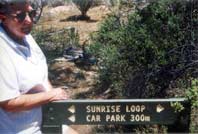National Parks: Birdwatching and Bushwalking
Warby-Ovens National Park
Extending for 25 km north of the town of Glenrowan is a steep scarped range known  locally as the Warbys. The combination of excellent viewing points along the ridge, pleasant picnic spots and outstanding variety of birdlife and wildflowers provides visitors with a memorable experience. This has now been incorporated into The Warby-Ovens National Park.
locally as the Warbys. The combination of excellent viewing points along the ridge, pleasant picnic spots and outstanding variety of birdlife and wildflowers provides visitors with a memorable experience. This has now been incorporated into The Warby-Ovens National Park.
Kurringai Cottage borders on the Warby Ranges and there is access from the rear garden. There are formally marked tracks – either a 20 minute walk or a short drive away.
The 14,655 ha Warby-Ovens National Park is characterised by three distinct vegetation communities – the granitic hills and woodlands of the Warby Range, the Box-Ironbark of the Killawarra Forest and the Redgum forest and wetlands of the unregulated Ovens Heritage River. Together they provide an important link from the alpine foothills to the Murray River protecting some of the State’s most significant bushland.
The Victorian Government created Warby-Ovens National Park, along with other new and expanded parks and over 200 conservation reserves, in June 2010 to protect and enhance the remaining River Red gum forests in Victoria.
Popular things to do
Bike riding and walking
Bike riding is permitted on open vehicle roads tracks and some management tracks including Pangarang Lookout Walk and Ridge Track.
Prospecting
A small area in the Killawarra section of the park is available for gemstone prospecting, in particular the mineral Wavelite.
Fishing
Murray Cod are frequently caught in the Lower Ovens River. Most are returned to the river to ensure the ongoing ensure the ongoing survival of this iconic fish.
Chiltern – Mt Pilot National Park (40 minutes by car)
This, recently expanded, 21,565ha park is located between Beechworth and the low hills
surrounding Chiltern and includes the striking Mt Pilot Range and Woolshed Falls. Chiltern-Mt Pilot National Park protects box-ironbark forest that once covered much of northeast Victoria and contains several historic goldmining sites. Short or daylong walks can be made on vehicle tracks through open forest and a 25km historic drive is marked from Chiltern through the forest and goldfields.
Things to Do
- Drive through the forest to Donchi Hill Lookout then on to the original Indigo goldfields cemetery — about an hour and a half’s round trip.
- Visit the open-cut Magenta Mine, which produced up to 13,000 ounces of gold between 1860 and about 1910. Horse-drawn drays carted away the rock for crushing in the nearby battery.
- Take a self-guided tour around Chiltern. This tour takes in Dow’s Pharmacy, which ran its business on the site for more than 100 years, an old smithy, the Atheneum library-museum, the Star Theatre, the Grapevine Hotel (named to honour the largest grapevine listed in Australia) and Lakeview, one of the childhood homes of Henry Handel Richardson, the author of The Fortunes of Richard Mahony.
- Enjoy easy walking as you follow the numbered pamphlet describing natural and historical features of the park along the 8.5km White Box Walking Track.
- Cycle on forest tracks at Donchi Hill in the west, Frogs Hollow and Magenta Mine and at Cyanide Dam.
- Visit Woolshed Falls and take the self-guided Woolshed Falls Historic Walk.
- Walk to the summit of Mt Pilot and enjoy the spectacular view.
- Visit the Yeddonba Aboriginal art site.
- Go bird watching and discover some of over 200 species found in the park.
- Stroll, drive or cycle through the park in spring to view the wildflower wonderland.
Fauna
The park is the habitat of several rare or threatened species — the Regent Honeyeater, Turquoise Parrot, Peregrine Falcon, the Brush-tailed phascogale and Squirrel Glider. Winter, when the ironbarks are in bloom, is the best time to see the birds. More than 150 bird species have been recorded in the area. Eastern Grey Kangaroos are often seen grazing in the late afternoon and smaller tree-dwelling creatures — Feathertail and Sugar Gliders, Brushtail and Ring-tail Possums — live in tree hollows in the southern areas. Many reptiles, including the Lace Monitor, also call the park home.
Beechworth Historic Park (30 mins by car)
This park, is 270 km north-east of Melbourne in the foothills of the Alps. People visit Beechworth for the natural beauty of the forests and ranges as well as the historical architecture of the town. It claims to be the best-preserved gold town in Victoria with more than 30 of its buildings classified by the National Trust. Outside the town, a number of significant goldmining sites are incorporated in sections of the 1080 ha Beechworth Historic Park. The tranquil beauty of eucalyptus and native cypress pine forests, winding creeks, steep gullies and rugged granite outcrops can be enjoyed for their own sake or viewed as the setting for the labors of the diggers.
Things to Do
- Walking, browsing, gem-fossicking, fishing, swimming and horse riding are popular.
- In Beechworth, visit the museum, powder magazine, the classical granite arches of the Goldfields Hospital facade, the Chinese burning towers, the jail, the former Regency Theatre and the Victorian churches, banks and public buildings. View the cell that twice held Ned Kelly, and visit the sites of bushranger gang hideouts.
- The Beechworth Forest Drive begins from the town and passes through the peppermint forest near Lake Kerferd.
- The 5 km Gorge Scenic Drive, also a pleasant walk, provides views of waterfalls and rugged countryside west of the town. It also passes the restored powder magazine, built to safeguard mining explosives.
- Other walking tracks connect Lake Sambell to Lake Kerferd, and a network of tracks link points of interest in the Gorge area including Fiddes Quarry, the precipice and cascades.
